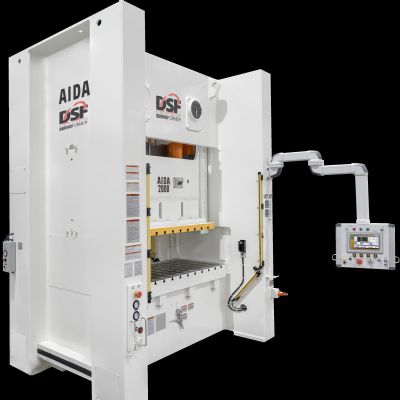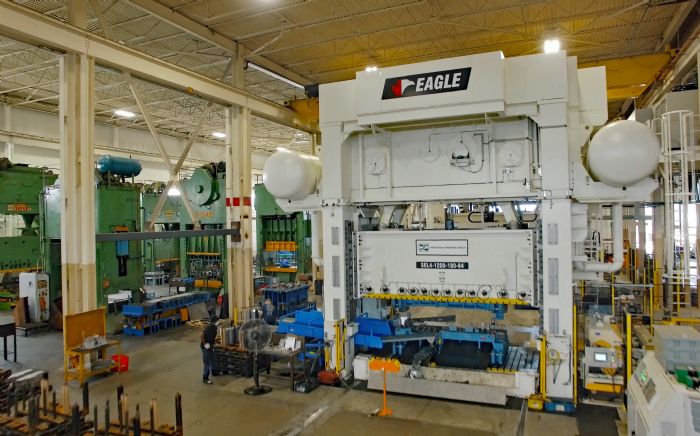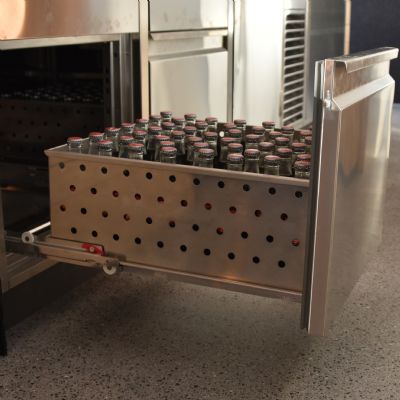Motion-Control Improvement for Hydraulic Presses
With expertise in hydraulics, Parker Hannifin, in its report, provides considerable detail on hydraulic presses in automotive part-supply operations.
“Hydraulic presses, powered by hydraulic cylinders, offer the highest tonnage capacities and are more reliable than other types of presses, but they lack the efficiency, speed and precision of pneumatic presses,” the report reads. “Traditional hydraulic presses use over-powered hydraulic systems, where the hydraulic pump and an unregulated electric motor run continuously at maximum motor speed. These systems typically have large hydraulic reservoirs and additional add-on cooling systems to burn off the excess power. Put simply, inefficient hydraulic systems generate heat and noise.”
Up-to-date motion-control systems can deliver vast performance improvements, according to Dan Detweiler, value-added systems and technical services manager of Parker’s fluid power team. He details the company’s drive-controlled pump technology, which combines electronic and hydraulic technologies, in the report.
“While the traditional hydraulic cylinder is still the workhorse, added to that are an AC drive, a matched hydraulic pump and a variable frequency drive -rated electric motor,” he offers.
Software pulls it together, according to Detweiler, and matches hydraulic flow and pressure to the demands of the press throughout the production cycle to help ensure optimal performance.
A properly designed system can reduce energy consumption significantly, generate considerably less heat and noise, improve production cycle time, and improve overall press performance.
“Used in combination with high-speed, closed-loop, servo-proportional valves and a solid hydraulic motion controller, the press’ positioning can be highly accurate and repeatable,” Detweiler says. “These presses also can incorporate production-data acquisition and process monitoring.”
Cobots Continue Gaining Ground
Industrial robots represent another automotive-manufacturing trend affecting production equipment, according to the Parker Hannifin report. Collaborative robots (cobots) have gained ground, working alongside and assisting assembly workers. A walk through the recent FABTECH show in September revealed a cobot explosion, with these units displaying the ability to assemble, weld, press-tend and more.
Lower forces and internal safeguards enable cobots to function without the need for safety barriers, thus allowing operation in tight spaces and in proximity to humans. Cobots can work nonstop on repetitive tasks, with their lightweight arms easily programmed and redeployed, making them flexible and cost-effective. They also can be taught complex tasks.
New Steels Test Stamping Equipment
New lightweight materials continue replacing traditional iron and steel alloys in motor vehicles, with advanced high-strength steel (AHSS), aluminum, magnesium, high-performance plastics, carbon fiber and other composites providing significantly less weight but comparable strength. These attributes prove especially important in electric vehicles, the Parker Hannifin report notes, where increases in efficiency extend battery range or enable a smaller battery to provide the same range as a larger battery in heavier vehicles.
Most grades in the AHSS family offer yield strengths surpassing 550 MPa, with each grade uniquely engineered with different chemical compositions and microstructures to meet different automotive requirements, the most critical being the combination of higher strength and lower weight. AHSS can reduce a vehicle’s total weight by as much as 40 percent compared to conventional steel, while improving its safety and crashworthiness. For steel sheet and coil used in presses, ductility (formability) represents another major requirement. AHSS grades are designed to be cold formed in traditional stamping presses at room temperature, which proves challenging, as higher-strength materials usually are more susceptible to different types of deformation during processing—the reduced thickness of AHSS increases its tendency to wrinkle, for example. In addition, stamping AHSS causes greater die wear, leading to development of more robust tool-steel dies and greater use of protective tool coatings. With newer 3rd-Gen AHSS grades in the pipeline, featuring tensile strengths exceeding 1200 MPa and improved ductility, expect continued development in tooling, and incorporation of increasingly robust coil handling equipment.
A perfect example of the AHSS ramifications for automotive stampers—and the trend toward larger presses and bigger beds with robust ancillary equipment—can be found at Tier Two automotive stamper Precision Stamping Group (PSG), with three production facilities around Windsor, Ontario, Canada. Recently, the automotive supplier invested to increase its available press-bed size, responding to customer requirements for larger tools, to take on more complex parts and even higher-strength steels, reports Brad Kuvin, MetalForming’s editorial director.
Specifically, in 2019 PSG welcomed a new 1200-ton progressive-die press from Eagle Press with a 180 by 84-in. bed, along with a 72-in.-wide feed line. Prior to that, the largest progressive-die press at PSG measured 144 by 72 in., with 1000-ton capacity.
“The difference between 144 in. and 180 in. is huge and very relevant to our business,” Cory Ladouceur, PSG vice president and part owner, tells Kuvin. “It’s the perfect size for the progressive-die opportunities we’re seeing; anything larger runs on a transfer press.”
Prior to bringing in the larger progressive-die press, PSG had quoted a new program (body-in-white underbody parts) for a customer that included tools larger than the 144-in. press could handle. This led to acquisition of a 2500-ton eccentric-drive Eagle transfer press with 240 by 96-in. bed and 30-in. stroke.
“Before we brought in the big transfer press,” company president and owner Chris Abt tells Kuvin, “we formed larger, heavier parts through a hand-transfer line of 1000-ton presses with 132 by 84-in. beds. Now we can make these parts under one ram, and with the required tonnage and press automation (a beefy transfer system from Linear Transfer) that creates a significant competitive advantage.”
Delivering coil stock—much of it AHSS with yield strength from 440 to 980 MPa, to the 1200-ton progressive-die press—falls on the shoulders of press’ 72-in. feed line with nine-roll straightener, from Colt Automation, fortified for working these high-strength alloys. The line can handle full-width 980-MPa material to 0.125 in. thick.
Get the full story at www.metalformingmagazine.com/article/?/stamping-presses/mechanical/bigger-dies-and-stronger-steels-mean-bigger-stronger-presses.
The Age of Industry 4.0
The increased integration of sensors, monitoring devices and software enables machines to better track and report on their own performance, alerting operators to problems resulting in reduced unplanned downtime. Small and accurate sensors, widely available, continuously measure and report on different machine variables and operating conditions, feeding into larger MES and ERP systems to provide sophisticated data analysis and planning.
Metal formers and fabricators most assuredly notice the increase in aftermarket services offered by machine providers, including maintenance, service agreements, spare parts and other value-added services. It has grown difficult for machine OEMs to find qualified service techs, according to the Parker Hannifin report, especially as older technicians retire and machines become more complex with the addition of digital technologies. As a result, machine manufacturers are shifting customer service to online platforms, with some now accessing their machines directly through a VPN. This enables technicians to troubleshoot and solve problems remotely, thus avoiding the time and cost of onsite visits. MF
View Glossary of Metalforming Terms
See also: Eagle Press & Equipment Co. Ltd., Linear Transfer Automation Inc., Parker Hannifin
Technologies: Stamping Presses
Comments
Must be logged in to post a comment. Sign in or Create an Account
There are no comments posted. Stamping Presses
Stamping PressesStamping Prog.-Die Parts on 300-Ton Straightside Servo Press
Thursday, June 12, 2025







 Stamping press capacities continue to increase, transitioning from machines in the 100 to 300-ton range to those featuring capacities of 1000 to 2000 tons or greater, with larger bed sizes increasingly desirable. For example, presses running 42-in.-wide steel coils can produce large, completed parts, negating the need for component assembly after stamping.
Stamping press capacities continue to increase, transitioning from machines in the 100 to 300-ton range to those featuring capacities of 1000 to 2000 tons or greater, with larger bed sizes increasingly desirable. For example, presses running 42-in.-wide steel coils can produce large, completed parts, negating the need for component assembly after stamping. 
